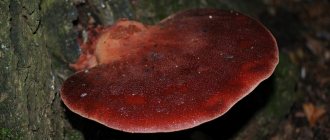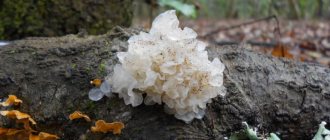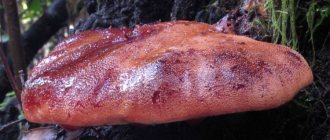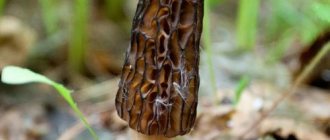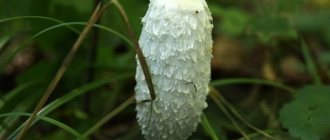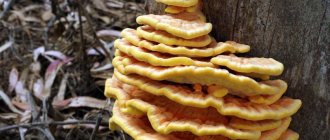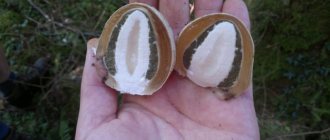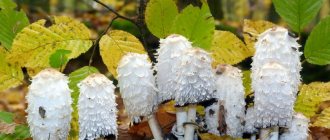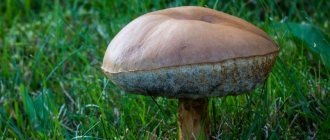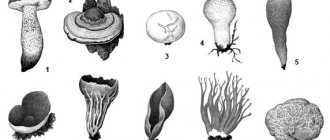Every mushroom picker has at least once encountered very unusual mushrooms growing on tree trunks in our forests. Most often they are ignored or not paid attention to at all. Few people know that there are several varieties of polypores that are considered edible and have high nutritional qualities. One of them is the liver fungus, also known as “mother-in-law’s tongue,” or common liverwort.
The liver mushroom got its name due to its appearance, because according to the description, the fruiting body is very similar to the liver of an animal, which is clearly visible in the photo.
Benefit
Liverwort is recommended for use by those who suffer from metabolic disorders. Due to the presence of special substances, mother-in-law's tongue activates the liver's production of enzymes necessary for normal metabolism. There is also a theory that this type of fungus is able to fight cancer cells, but there is no official evidence of this.
Pathogenesis
Yeast fungi in the human body are considered to be opportunistic microflora . They may be present in the microflora, and if the immune system is strong, then the fungal infection does not cause diseases, for example, urogenital, respiratory, skin, or, as in this case, the mucous membranes of the oral cavity. Normally, in almost 70% of the population, yeast fungi are present in the resident microflora; they are inactive and do not cause candida or other fungal diseases. Reproduction usually occurs by budding and spores. Proliferation occurs not due to the departure of daughter cells from the mother cells, but through elongation and formation of a pseudomycellar tree. As a result of vital activity, toxic substances are released that weaken the human immune system.
Model of a fungus cell of the genus Candida
alcohol and drug abuse, oncology, and the use of contraceptives contribute to imbalance of the oral microflora and excessive proliferation of opportunistic fungi . Fungus in the mouth is most often a superficial disease that affects the mucous surface of the cheeks, the corners and borders of the lips, the back of the tongue, the palate, etc., but with significant spread and penetration into the bloodstream it can cause systemic chronic and generalized disorders.
In neutropenic or severely ill patients, candidal fungal infection can enter the bloodstream, where it causes widespread visceral dissemination. Generalized mycosis can lead to candida sepsis and even death.
Other names
The mushroom has quite a few synonymous names. In English-language literature, chestnut and oak tongue, mushroom steak, and ox tongue are found. And this is simply explained: a bright appearance evokes many associations, which are enshrined in popular names:
- bugloss;
- liverwort mushroom;
- Mother-in-law's tongue.
Mature liver mushroom stains your fingers deeply red, so wear gloves when picking it.
Characteristics of liver mushrooms
The liverwort is the only representative of the genus Fistulina. By general characteristics, it resembles a fruit from the Tinder family, for which the mother-in-law’s tongue is a distant “relative”.
Appearance and photo
The common liverwort lives on tree trunks and leads a parasitic lifestyle, drawing juices from the wood. In its shape, it resembles a cattle hoof, which often scares away mushroom pickers.
Externally, the mushroom is very similar to raw animal liver, and in the cut areas it even begins to “bleed”, which is clearly visible in the photo.
Structure and species differences
The size of the fruiting body varies between 10-30 cm, and its thickness can reach no more than 6 cm. The mushroom is fleshy and dense, it can be sessile or with a thick small stalk that forms on the side. Sometimes the stem may be buried in the soil, but generally it is attached to the trunk.
The young fruit has a tuberous shape about 5 cm, which resembles an ox tongue. As the mushroom grows, it takes on a wider shape with pointed edges. The surface is wet and brown or red. The rough skin of more mature specimens becomes gelatinous.
The pulp of the fruiting body is quite dense, fleshy and juicy. It has a dark red tint, on which you can see light veins. The radially fibrous flesh resembles liver or raw meat. The smell of the fruit is weak, with fruity notes. The taste of the pulp is sour, sometimes a bitter taste appears.
The hymenophore of this species has an unusual structure. It consists of small individual tubes that can be easily separated. In young fruits, the tubes are difficult to see, and with age the thickness of the layer reaches 1-1.5 cm. The surface is porous and moist. Often, droplets of liquid with a reddish tint can be seen on a straw-yellow or pink surface. When pressed, the color changes to brown-red.
The color of the spore powder is pink, red-brown and white. The spores are round in shape and reach 4.5×5 µm.
Ecological characteristics and distribution location
The liverwort fungus is a parasite and destroyer of trees, because its appearance provokes the development of brown rot of the tree core. The fruit parasitizes on old trees, among which chestnuts and oaks are most often found. It can grow on other deciduous trees and even stumps. The fruiting body is annual and is formed near the root system or on the lower part of the tree. Mushrooms can grow either singly or in small groups.
Mushroom growth sites
Liverworts grow in warm weather after good rain. This is not a very common species, so it is rarely found. You can go hunting from the end of July until the first frost. You should look for the mushroom in oak or mixed forests.
Eating
Liverwort belongs to the fourth food category. It is recommended to collect only young specimens, because old fruits are tough and bitter in taste.
Advice!
To remove bitterness, you should soak the crop in cold water for about a day. Be sure to remove the mucus from the cap and boil for 30 minutes. Liver mushroom is prepared in a variety of ways: boiled, fried, dried and stored for the winter.
Collection rules and conditions
The mushroom begins to bear fruit in mid-summer. In warm regions you can find this species even in November, but it mainly grows until October. It grows unsteadily and there are often lean years. Liverwort settles on weakened and old deciduous trees.
It loves a temperate warm climate, so you should look for it in those regions where winters are short and fairly warm. In European countries, Belarus and some regions of Russia, this species is listed in the local Red Books, because it is considered quite rare.
Unlike most representatives of the mushroom world, the liverwort mushroom does not have false and poisonous counterparts, so even inexperienced mushroom pickers can collect it. Among the forest inhabitants there is not a single one similar to the liver, except for the mother-in-law's tongue.
Application
Mother-in-law's tongue (the mushroom whose photo you see in the article) can rarely be found on the shelves of regular stores. However, due to the fact that it contains a large amount of protein and vitamins, many use it as the main component of various dishes. In addition, many also believe in the healing properties of this mushroom.
In cooking
Mother-in-law's tongue is a conditionally edible mushroom, so it is best to use younger specimens for preparing various dishes. You can use them to make various vegetarian cutlets, roasts or kebabs. Liverwort is also often added to salads, fried, boiled, or added to vegetable stews.
In medicine
In folk medicine, mother-in-law's tongue is used to increase immunity and fight various infections and viruses. This mushroom is also known as an excellent antioxidant that can cleanse the body of waste and toxins. The main thing is to pay attention to a number of contraindications so as not to further harm your body.
Description of appearance
| Hats | The cap can reach up to 5 to 20 cm in diameter. Some sources say that the size can even increase to 30-35 cm, which is far from the limit. The top can be called fleshy. The cap, closer to the base, reaches a thickness of up to 7 cm. It has an irregular, semicircular, fan-shaped or reed shape, and is characterized by a lobed and wavy edge. Juveniles have a wet, wrinkled, smooth and sticky surface that tends to dry out as the individual matures. The surface has a liver-red color, combining reddish-orange or brownish-red shades. |
| Legs | Lateral, slightly pronounced, you can often observe their absence or being in their infancy. The legs are colored to match the color of the caps, with a whitish color on the lower sides. They are covered by a hymenophore (hymenophore is a spore-bearing layer). The legs are strong, dense and thick. |
| Spore-bearing layers (hymenophore) | It can be called tubular. It has whitish or pale pinkish shades, after a while it acquires a yellowish color, and when the mother-in-law ages, the mushroom acquires a reddish-brown color. The slightest damage or slight pressure can cause the appearance of reddish, red-brownish or fleshy brown spots. The tubes have clear divisions, they are round in diameter and can reach up to 1.5-2 cm in length. |
| Pulp | It has a whitish color and reddish stripes. In cross-section it has an extremely memorable and attractive appearance, on which you can see any patterns reminiscent of marble materials. The pulp is thick, soft and watery and exudes red juice when pressed. |
| Aroma | Gives off a weak mushroom aroma or has no odor at all. |
| Taste qualities | Gives off a sour taste, but may be tasteless. |
| Spore powder | It has a pale pinkish, brownish-brown, rusty pink or pale brown color. |
| Microscopic feature | The spores can be called almond-shaped, sublacrimoid or subellipsoid, smooth and flowing. They have yellowish tints. |
Plant propagation
There are two ways to obtain new specimens of liverwort: vegetative and seed. It's difficult to say which one is preferable. Natural forms are best propagated vegetatively, since their seeds do not always set well, seedlings are rare, and you have to wait a long time for them. Species forms perform better in this regard. However, it is worth remembering that terry varieties do not form seeds. Seedlings bloom only in 3-4 years.
The vegetative method of propagation involves dividing the rhizome. It forms as the plant matures. The rhizome has several growth points and thin bunched roots. It can be divided into 3-4 parts, but so that 2-3 buds remain on each. It is better to root small cuttings in a greenhouse, while large ones should be rooted directly into open ground. It is recommended to divide the rhizome during the plant's dormant period - July-August. As a rule, by autumn new plants take root, winter safely and bloom next spring.
Causes
The cause of fungus in the mouth is an imbalance of microflora and the pathogenic effect of prevailing conditionally pathogenic yeast fungi. The most common pathogens of the genus Candida are Albicans, krusei C, parapsilosis, tropicalis, pseudotropicalis, lusitaniae, dubliniensis and glabrata.
Infection can occur from the outside - during the passage of the birth canal, through sexual contact, kissing and everyday interactions with a sick person. Chronic microtraumas from the edges of teeth, poor dentures, serious illnesses, reduced immunity (including those caused by AIDS), chaotic use of antibiotics, excessive use of antiseptics, and the virulence of the pathogen also contribute to the penetration and growth of yeast fungi in the mouth.
Evaluation of taste qualities, medicinal properties, benefits and possible harm
When young, before the flesh becomes woody, Fistulina hepatica is considered a good edible mushroom with a delicate flavor and a strong sour taste. It can be cooked in a frying pan, added to salads with herbs and olive oil, pickled, frozen, boiled, pickled, fried, or made into cutlets.
Interesting! The liverwort is rich in vitamin C: 100 g of its pulp contains the daily intake for an adult.
Experts who study the medicinal qualities of mushrooms claim that liverworts are very useful in the treatment of cancer. They restore disrupted metabolic processes, help cleanse the body and are excellent antioxidants.
Note! Any treatment must be prescribed and accompanied by a doctor. Self-medication is unacceptable and will lead to negative consequences!
Mother-in-law's tongue is rich in ascorbic acid, it contains:
- vitamins D and PP;
- minerals;
- proteins;
- phosphorus;
- carbohydrates;
- water.
It is not recommended to use these mushrooms for diseases of the gastrointestinal tract, kidneys, liver and gout. It is not advisable to give dishes from it to children.
General information
Mycosis of the mucous membranes of the oral cavity ( stomatitis or thrush ) is usually a dysbiosis , it is provoked by yeast fungi and most often by the genus Candida. A fungal infection can affect both adults and children, regardless of gender, the main condition is the presence of severe illness or long-term antibiotic therapy, but most often it affects infants or elderly people who have a chronically weakened immune system , the functioning of other systems is not adapted or impaired, and organs.
It can occur as an independent pathology, be a secondary infection or a manifestation of other chronic diseases.
How to deal with the disease - treatment methods
General and local remedies will help cure candidiasis. However, only a doctor can select the appropriate set of medications after diagnosing and identifying the causes of the disease. So, how to get rid of fungus on the tongue? Common treatment methods are discussed below.
General agents
To quickly and reliably remove manifestations of infection in the mouth, drugs are usually prescribed that affect not only the affected area, but the body as a whole, helping to remove infection from the blood. In such situations, antibiotics are often prescribed - Levorin and Nystatin tablets. Already on the fifth day after the start of treatment, the symptoms begin to subside, and a clear decrease in plaque can be noticed.
Medicines will relieve symptoms on the 5th day
In advanced stages, the doctor may suggest Amphotericin (intravenously administered) or a course using Amphoglucamine in tablet form. Additionally, multivitamin complexes and calcium gluconate are prescribed to strengthen the immune system.
Local remedies
Topical medications help relieve visible manifestations of the disease in localized areas. They help relieve redness, eliminate discomfort in the oral cavity, restore the integrity of the mucous membrane and stop the proliferation of pathogenic microorganisms. Often, treatment of the affected areas with Fukortsin and brilliant green is prescribed, or Lizak or Lysozyme are suckable tablets. If pathological processes have affected the lips, levorin or nystatin ointment is recommended.
Important! You can start taking pills and using external products only with the permission of your doctor. Self-medication is strictly prohibited - otherwise, you can cause a sharp deterioration in the condition. The same applies to the use of folk remedies - only after agreement with a specialist.
You will also need to undergo complete sanitation of the oral cavity, which will stop the spread of infection and prevent it from “spreading” to new, untouched tissues.
Prevention
There are a number of preventive measures to prevent the development of fungus in the oral cavity, these include:
- regular visits to the dentist, at least 2 times a year;
- taking medications that strengthen the immune system and following a healthy, nutritious diet;
- compliance with the rules of oral hygiene - cleansing plaque with toothpaste and rinses 2 times a day;
- quitting smoking and alcohol;
- minimal consumption of foods high in sugar and yeast, these include baked goods and other bakery, confectionery products, beer, etc.
Tests and diagnostics
To confirm the diagnosis, microscopic examination of crusts and other biological tissues, fluids or scrapings is carried out, depending on the location of the pathology. As a result, fungal mycelium is detected. It is quite important to identify the causative microorganism (PCR diagnostics, ELISA, cultural inoculation with quantitative monitoring can be used for this), since various types of fungi can exhibit resistance to antifungal drugs.
Additional studies include checking for gastrointestinal pathologies, diabetes mellitus and leukemia .
Carry out differential diagnosis:
- with eczema - characterized by the formation of weeping surfaces after the opening of the blisters, redness and swelling are more pronounced;
- with leukoplakia , manifested by the development of plaques and opacities of areas of the epithelium;
- with allergic, streptococcal stomatitis, cheilitis and other similar lesions of a different nature.
What is recommended to rinse your mouth with?
As part of the treatment, various rinses are recommended. As a rule, specialists prescribe solutions for disinfection; they help remove plaque, remove secretions from other areas of the mucous membrane, suppress inflammation, and also heal microtraumas on soft tissues. In such situations, a 2% solution of regular baking soda or a mixture of iodinol and water is often used. It is recommended to repeat rinsing every couple of hours, as well as after waking up and before going to bed. On average, the course lasts about 2 weeks. However, therapy should never be started without the consent of a specialist. Before performing the first procedure, consult your doctor.
Rinsing is prescribed by the attending physician
Preventive measures
After recovery, it is important to take care of preventing relapses. To do this, you need to maintain oral hygiene, brush your teeth at least twice a day with a brush and paste, use special floss to clean the interdental spaces and rinse your mouth with water every time after eating. These are basic rules, the observance of which will significantly reduce the risk of recurrence of candidiasis symptoms. Also, do not forget to renew your toothbrush every 4 months and visit your dentist every six months for preventive examinations. In order to maintain the body's immune strength, doctors advise taking vitamin complexes from time to time, eating more vegetables and fruits, leading a more active lifestyle, and also spending more time in the fresh air.
- Statistics from WHO - World Health Organization.
In children
In infancy, oral mycosis is usually caused by Oidium albicans and is called thrush. Small children under one year old require special attention, because fungus in the mouth and other mucous membranes of babies can occur as a result of:
- breastfeeding or passing through the birth canal of an infected mother;
- violation of hygiene standards - use of unsterile utensils, things, household items, etc.;
- sexual contact, for example, oral sex;
- excessive consumption of sugars, for example, during artificial feeding.
Despite the fact that thrush in children tends to return, it is easier to tolerate than in adults and can be treated, in more rare cases it can provoke a fungus on the tonsils in a child, enter the body along with food during swallowing and provoke intestinal dysbiosis .
Diet for candidiasis on the tongue
Compliance with certain dietary restrictions is an important point in treatment. For example, experts strongly recommend avoiding products with yeast. Too spicy and sour foods provoke irritation of the oral mucosa, which can cause an unpleasant tingling sensation and even pain. During recovery, doctors advise eating mainly liquid and warm food. In this case, spices and acid-containing foods will have to be excluded for a while.
You need to return to your usual diet gradually. For three months you will have to give up sweet and fatty foods, carbonated water, mushrooms, as well as confectionery and alcoholic drinks.
